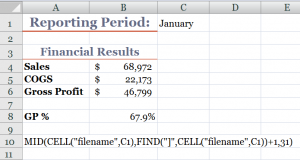I am excited to share this Excel Tip with you! Several viewers have recently asked if there was a way to create a link in a cell to the name of a worksheet tab. Yes there is! And, in this lesson, I demonstrate how to do this.
Say, for example, that you want Cell C1 to contain the name of the current worksheet (Sheet1). With this formula, when you change the name of the worksheet to “January,” cell C1 is dynamically updated to show “January.”
Perfect for Excel Templates
If you use a template for your monthly, regional sales or financial reports, then this Excel formula is essential. You write the formula once – using Group edit – and each worksheet in your Excel workbook will be linked to a cell in your report. Change the name of the worksheet and your report name is automatically updated.
Functions Used in this Formula
- CELL() – to gather information about the worksheet – in this case, the “Filename.”
- MID() – to extract the characters in a text string – e,g, the “worksheet name.”
- FIND() – to locate the starting point for the MID() function to extract the characters in the text.
As the final argument for the MID() Function, I use 31 characters because that is the maximum number of characters that you can use when naming an Excel worksheet.
Try this for yourself. Let me know how it works for you. Add your comments below.
Download Excel Workbook for this Lesson
- Follow this link to access the Excel Workbook that I used in this lesson. I store my files on my SkyDrive at www.office.live.com
Watch Video in High Definition
Follow this link to view this video tutorial on my YouTube Channel – DannyRocksExcels
I invite you to watch or to subscribe to my video podcast on iTunes. Follow this link to learn more about my RSS Feed.
 Create a Link to an Excel Worksheet Name in a Cell [ 6:06 ] Play Now | Play in Popup | Download (1667)
Create a Link to an Excel Worksheet Name in a Cell [ 6:06 ] Play Now | Play in Popup | Download (1667)















How to Annotate Excel Worksheets with Comments and Images
Do you use “post-it” sticky notes to remind you how to do something? Do you ever lose your reminder notes? I know that I do! So that is why I like to annotate my Excel Worksheets with Comments – this way I have the notes properly located (in the worksheet) when I need them (to remember how to write a particular formula, etc.) the most!
In this lesson, I also show you how to add “pictures” inside your comments. This is a great tip for adding in a picture for a catalog or order form.
A question that I am frequently asked: “How do I print out my comments?” Watch this video to find out how to do this – there are a couple of “got’cha” steps involved.
The 50 Best Tips
Here are three ways to enter a new comment that is attached to a single cell:
You can edit your comments, re size the shape of your comments, hide your comments (only a “red triangle” shows in the cell until you hover near the cell), show your comments (individually or collectively), delete, clear and paste your comments. I cover each of these techniques in this video lesson. And more!
Watch this video in High Definition, Full Screen Mode on my YouTube Channel – DannyRocksExcels
Learn how to “Master Excel in Minutes – Not Months!”